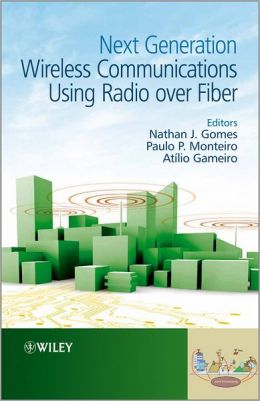 [内容简介]
[内容简介]
aking a coherent and logical approach, this book describes the potential use of co-ordinated multipoint systems supported by radio over fiber. It covers an impressive breadth of topics, ranging from components, subsystem and system architecture, to network management and business perspectives. The authors show the importance of radio over fiber in eliminating or mitigating against the current, perceived barriers to the use of co-ordinated multipoint, and the drivers for standardisation activities in future mobile/wireless systems over the next few years.
The book brings together the system concept for centralized processing, including what is required for co-existence with legacy wireless systems, the algorithms that can be used for improving wireless bandwidth utilization at physical and MAC layers and the radio over fiber network and link design necessary to support the wireless system. Other important research is also covered as the authors look at compensating for radio over fiber impairments and providing simple network management functions. A study of service provision and the business case for such a future wireless system is also fully considered.
This book comes at an important time for future wireless systems with standardization of fourth generation wireless systems still ongoing. The content enables readers to make key decisions about future standardisation and their own research work. The business analysis also makes the book useful to those involved in deciding the future directions of telecoms organisations. This information will be core to their decision-making as it provides technical knowledge of the state-of-the-art but also system level assessments of what is possible in a business environment.
[目录]
List of Contributors xiii
Foreword xv
Preface xvii
Acknowledgments xxi
List of Abbreviations xxiii
1 Background and Introduction 1
Paulo P. Monteiro, Atýlio Gameiro and Nathan J. Gomes
1.1 The Trends and Challenges to Achieving 4G Wireless 2
1.2 The FUTON Concept for Next-Generation Distributed and Heterogeneous Radio Architectures 8
1.3 Overview of this Book 12
2 Trends inWireless Communications 17
Aarne Mammela, Mika Lasanen and Jarno Pinola
2.1 Introduction 17
2.2 Basic Transmission Problems and Solutions 18
2.3 Regulation and Standardization 37
2.4 Conclusions 41
3 System Concepts for the Central Processing of Signals 47
Atýlio Gameiro and Daniel Castanheira
3.1 Introduction 47
3.2 Wireless Trends 48
3.3 Architecture Options 51
3.4 The Global Centralized Architecture 52
3.5 FUTON Scenarios 55
3.6 The Optical Infrastructure 58
3.7 Conclusions 60
4 Introduction to Radio over Fiber 61
Nathan J. Gomes and David Wake
4.1 Introduction 61
4.2 The Concept of a Radio over Fiber System 62
4.3 Categories of Radio over Fiber Systems 64
4.4 Performance of Radio over Fiber Systems 72
4.5 Applications of Radio over Fiber Technology 79
4.6 Conclusions 84
5 Radio over Fiber System Design for Distributed Broadband Wireless Systems 91
David Wake and Nathan J. Gomes
5.1 Introduction 91
5.2 Radio over Fiber Link Design Issues 93
5.3 Example Link Design 97
5.4 Analog or Digital Transmission? 108
5.5 Conclusions 110
6 Optical Network Architectures for the Support of Future Wireless Systems 113
Sýlvia Pato and Jo~ao Pedro
6.1 Introduction 113
6.2 Using PONs to Support Radio over Fiber Services 114
6.3 Candidate Architectures 117
6.4 Power-Loss Budget Analysis 122
6.5 Comparative Economic Analysis 128
6.6 Support of Legacy Systems 130
6.7 Conclusions 131
7 Optical Transmitters for Low-Cost Broadband Transport 133
Guilhem de Valicourt, Romain Brenot, Frederic Van Dijk and Guanghua Duan
7.1 Introduction 133
7.2 Basics of Semiconductor Lasers and Reflective SOAs 133
7.3 Semiconductor Lasers for Radio over Fiber Applications 139
7.4 Reflective Semiconductor Optical Amplifiers 148
7.5 Conclusions 157
8 Algorithms for Coordinated Multipoint Techniques 159
Fabian Diehm, Mohamed Kamoun and Gerhard Fettweis
8.1 Introduction 159
8.2 Basic Ideas about CoMP 160
8.3 CoMP in Cellular Systems: Benefits and Practical Design 163
8.4 Numerical Illustrations of CoMP Concepts 169
8.5 CoMP in the FUTON System Concept 174
8.6 The FUTON Prototype: CoMP with the FUTON RoF Architecture 177
8.7 Conclusions 186
9 Cross-Layer Resource Allocation and Scheduling 191
Ilkka Harjula, Mikko Hiivala, Vinay Uday Prabhu, Dimitris Toumpakaris and Huiling Zhu
9.1 Introduction 191
9.2 Low-Complexity Chunk-Based Resource Allocation for the Downlink 192
9.3 Modified MAC-Aware Per-User Unitary Rate Control Scheme 197
9.4 Channel Estimation Based on Superimposed Pilots 201
9.5 Conclusions 209
10 Compensation of Impairments in the Radio over Fiber Infrastructure 211
Atso Hekkala, Mika Lasanen, Mikko Hiivala, Luis Vieira, Nathan J. Gomes, Vincent Kotzsch and Gerhard Fettweis
10.1 Introduction 211
10.2 Compensation Techniques for RoF Links 212
10.3 RoF Link Model 214
10.4 Distortion Compensation Algorithms and Architectures 222
10.5 Distortion Compensation Analyses, Simulations and Measurements 227
10.6 Impact of Timing Delays in Centralized Distributed Antenna Systems 232
10.7 Conclusions 243
11 Radio over Fiber Network Management 247
Carlos Santiago, Bodhisattwa Gangopadhyay and ArturArsenio
11.1 Introduction 247
11.2 Overview of RoF Management Systems 248
11.3 RoF Manager Architecture 251
11.4 Interoperation of RoF Manager and Middleware 256
11.5 Conclusions 262
12 System-Level Evaluation 265
Ramiro Samano-Robles and Atýlio Gameiro
12.1 Introduction 265
12.2 System-Level Simulation of Wireless Networks and DAS 269
12.3 The FUTON System-Level Simulator 272
12.4 Radio Resource Management Implementation for the DBWS 285
12.5 Results of the Simulation 286
12.6 Conclusions 289
13 Business Evaluation and Perspectives 291
George Agapiou, Vitor Sim~oes Ribeiro, Angela Maria Ferro Venturi, Silmar Freire Palmeira and A. Manuel de Oliveira Duarte
13.1 Introduction 291
13.2 Evolution of Services in Advanced Access Technologies 292
13.3 Business Model Description 293
13.4 Business Plan 294
13.5 Market Characterization 296
13.6 Modeling the Business Plan 297
13.7 Deployment Models 304
13.8 Conclusions 312
14 Summary and Conclusions 313
Paulo P. Monteiro, Atýlio Gameiro and Nathan J. Gomes
14.1 Introduction 313
14.2 Main Achievements of the FUTON Project 313
14.3 Technical Benefits 314
14.4 Business Benefits 315
14.5 Business Vision 315
References 316
Index 317

 新书报道
新书报道